Abstract
Recent evidence suggests that T cell apoptosis could be involved in the pathogenesis of HIV-1 infection. As the progression of HIV-2 associated disease appears to be slower than that of HIV-1, we investigated whether there were differences in the degree of T cell death and apoptosis in peripheral blood mononuclear cell (PBMC) cultures from patients with HIV-1 or HIV-2 infection. PBMC from healthy controls (n = 28) and patients infected with HIV-1 (n = 26: asymptomatic (ASY)/persistent generalized lymphadenopathy (PGL), n = 16; and AIDS-related complex (ARC)/AIDS n = 10) or HIV-2 (n = 30: ASY/PGL, n = 16; ARC/AIDS, n = 14) were cultured in the absence or presence of mitogens (PHA, PWM) or superantigen (SEB). After 48 h, cell death (CD) was assessed by trypan blue exclusion and in some patients programmed cell death (PCD) was quantified in flow cytometry by measuring the percentage of hypodiploid nuclei corresponding to fragmented DNA, after treating the cells with a propidium iodide hypotonic solution. HIV-1 and HIV-2 ARC/AIDS patients and ASY/PGL HIV-1+ patients had significant increases in cell death percentages compared with controls, both in unstimulated and stimulated lymphocyte cultures. However, HIV-2+ ASY/PGL patients did not exhibit significant increases of cell death in unstimulated cultures. In addition, the comparison between HIV-1 and HIV-2 infected subjects in similar stages of disease, showed no significant differences in CD in the ARC/AIDS patients, although ASY/PGL HIV-2 infected subjects had lower levels of CD than the HIV-1+ ASY/PGL (3.4% +/- 0.6 s.e.m. versus 6.8% +/- 1.1 s.e.m., P < 0.01). PCD was significantly increased both in ASY/PGL (14.3% +/- 2.2 s.e.m., n = 8, P < 0.005) and in ARC/AIDS (25.3% +/- 4.5 s.e.m., n = 9, P < 0.001) HIV-1+ patients compared with healthy controls (5.8% +/- 1.7 s.e.m., n = 11). This contrasts with HIV-2 infected subjects where the ASY/PGL patients (10.0% +/- 2.8 s.e.m., n = 6) did not differ significantly from healthy controls, although ARC/AIDS patients (27.2% +/- 4.2 s.e.m., n = 9, P < 0.001) had significantly increased levels of PCD. In conclusion, this is the first report describing the occurrence of spontaneous and activation-induced lymphocyte death by apoptosis in HIV-1 infected subjects.(ABSTRACT TRUNCATED AT 400 WORDS)
Full text
PDF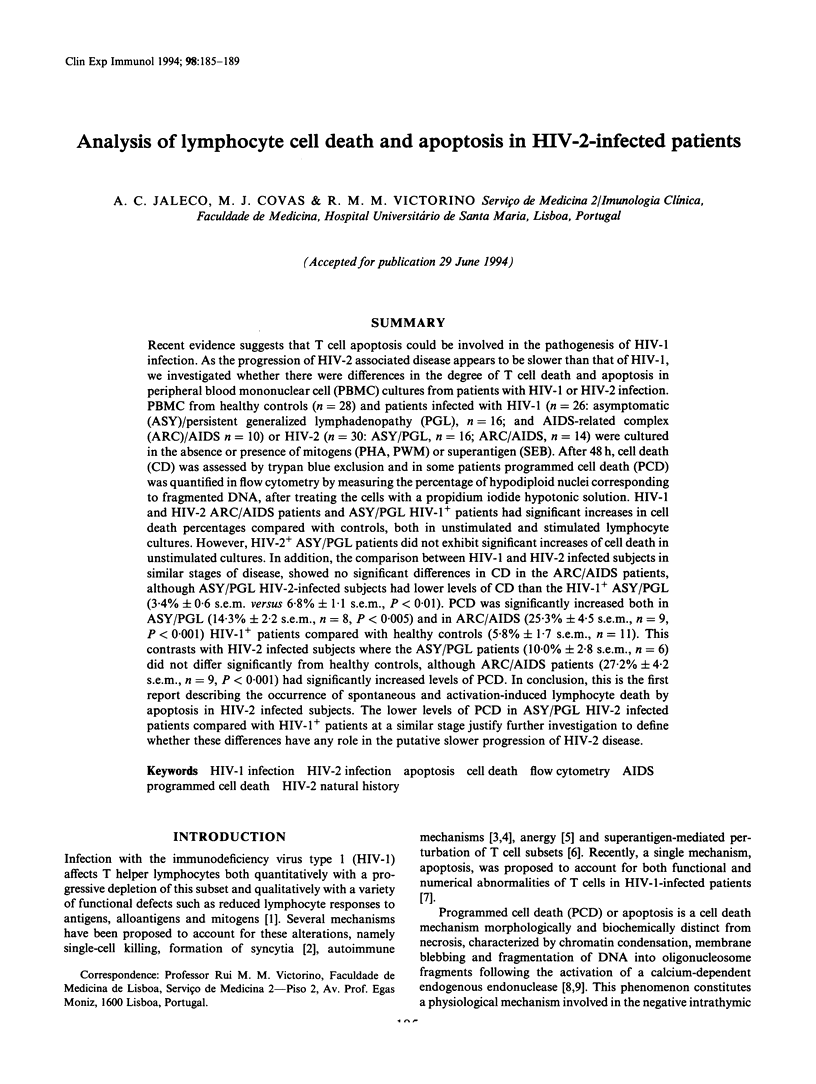
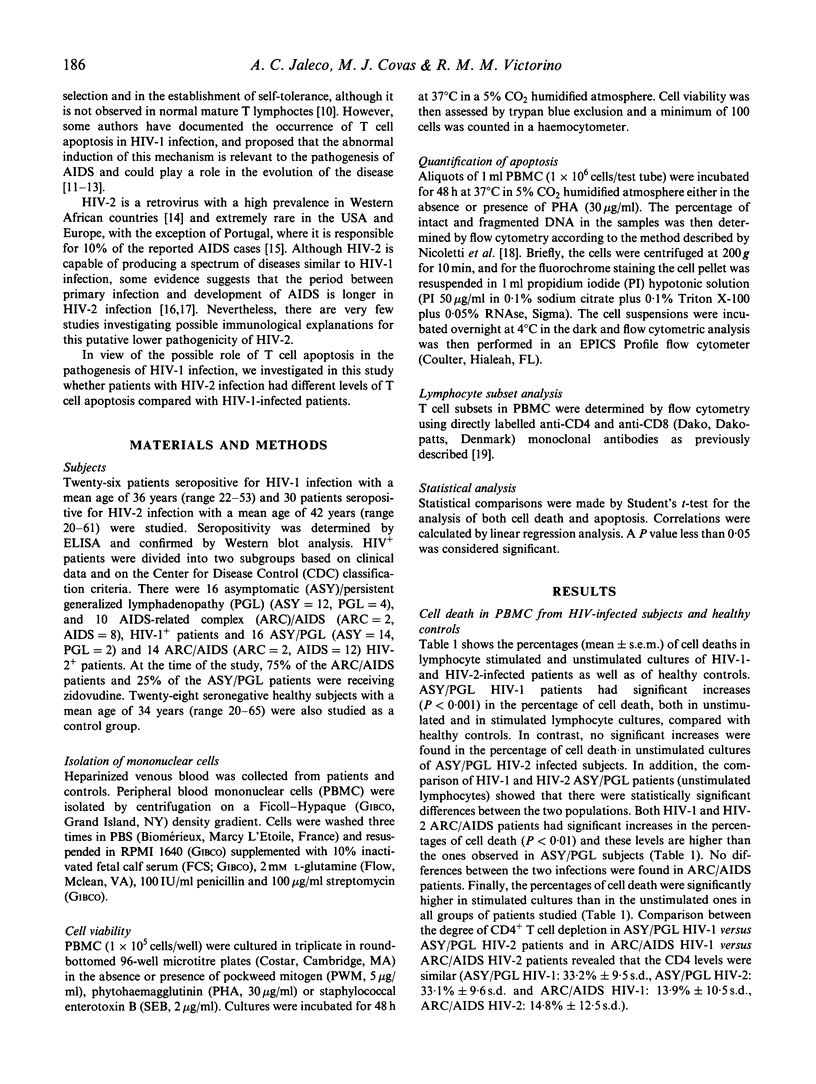
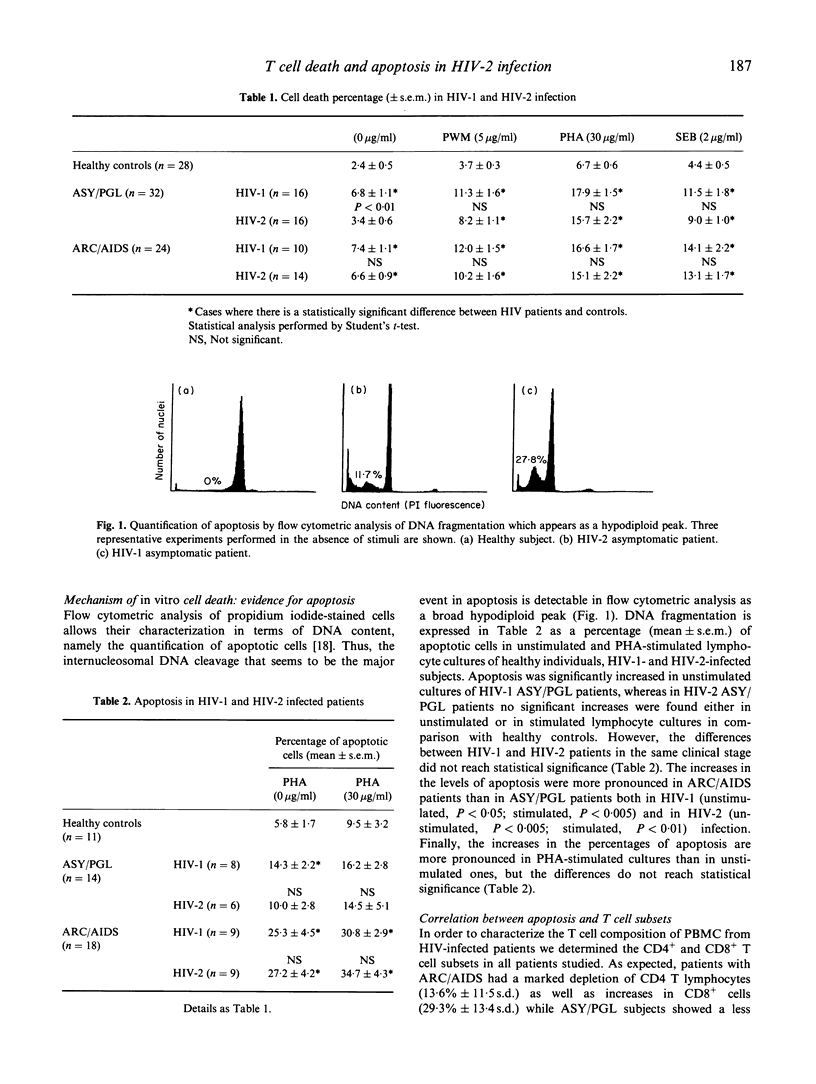
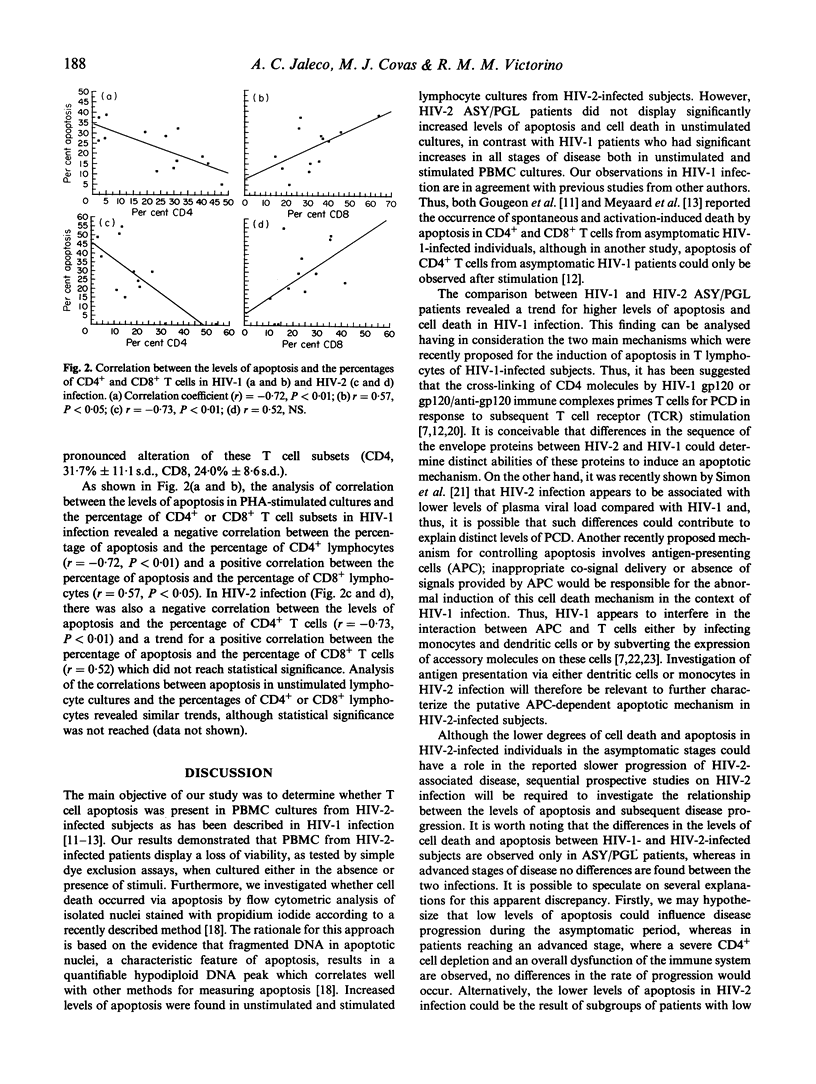
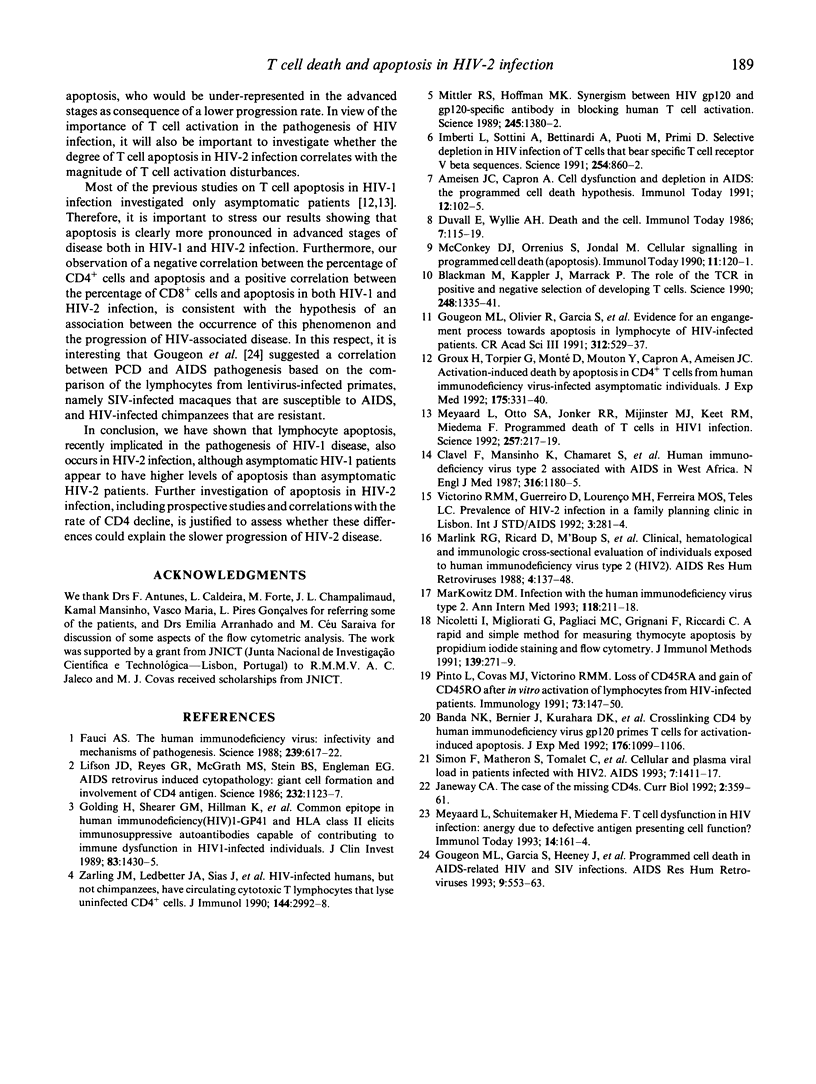
Selected References
These references are in PubMed. This may not be the complete list of references from this article.
- Ameisen J. C., Capron A. Cell dysfunction and depletion in AIDS: the programmed cell death hypothesis. Immunol Today. 1991 Apr;12(4):102–105. doi: 10.1016/0167-5699(91)90092-8. [DOI] [PubMed] [Google Scholar]
- Banda N. K., Bernier J., Kurahara D. K., Kurrle R., Haigwood N., Sekaly R. P., Finkel T. H. Crosslinking CD4 by human immunodeficiency virus gp120 primes T cells for activation-induced apoptosis. J Exp Med. 1992 Oct 1;176(4):1099–1106. doi: 10.1084/jem.176.4.1099. [DOI] [PMC free article] [PubMed] [Google Scholar]
- Blackman M., Kappler J., Marrack P. The role of the T cell receptor in positive and negative selection of developing T cells. Science. 1990 Jun 15;248(4961):1335–1341. doi: 10.1126/science.1972592. [DOI] [PubMed] [Google Scholar]
- Clavel F., Mansinho K., Chamaret S., Guetard D., Favier V., Nina J., Santos-Ferreira M. O., Champalimaud J. L., Montagnier L. Human immunodeficiency virus type 2 infection associated with AIDS in West Africa. N Engl J Med. 1987 May 7;316(19):1180–1185. doi: 10.1056/NEJM198705073161903. [DOI] [PubMed] [Google Scholar]
- Fauci A. S. The human immunodeficiency virus: infectivity and mechanisms of pathogenesis. Science. 1988 Feb 5;239(4840):617–622. doi: 10.1126/science.3277274. [DOI] [PubMed] [Google Scholar]
- Golding H., Shearer G. M., Hillman K., Lucas P., Manischewitz J., Zajac R. A., Clerici M., Gress R. E., Boswell R. N., Golding B. Common epitope in human immunodeficiency virus (HIV) I-GP41 and HLA class II elicits immunosuppressive autoantibodies capable of contributing to immune dysfunction in HIV I-infected individuals. J Clin Invest. 1989 Apr;83(4):1430–1435. doi: 10.1172/JCI114034. [DOI] [PMC free article] [PubMed] [Google Scholar]
- Gougeon M. L., Garcia S., Heeney J., Tschopp R., Lecoeur H., Guetard D., Rame V., Dauguet C., Montagnier L. Programmed cell death in AIDS-related HIV and SIV infections. AIDS Res Hum Retroviruses. 1993 Jun;9(6):553–563. doi: 10.1089/aid.1993.9.553. [DOI] [PubMed] [Google Scholar]
- Gougeon M. L., Olivier R., Garcia S., Guetard D., Dragic T., Dauguet C., Montagnier L. Mise en évidence d'un processus d'engagement vers la mort cellulaire par apoptose dans les lymphocytes de patients infectés par le VIH. C R Acad Sci III. 1991;312(11):529–537. [PubMed] [Google Scholar]
- Groux H., Torpier G., Monté D., Mouton Y., Capron A., Ameisen J. C. Activation-induced death by apoptosis in CD4+ T cells from human immunodeficiency virus-infected asymptomatic individuals. J Exp Med. 1992 Feb 1;175(2):331–340. doi: 10.1084/jem.175.2.331. [DOI] [PMC free article] [PubMed] [Google Scholar]
- Imberti L., Sottini A., Bettinardi A., Puoti M., Primi D. Selective depletion in HIV infection of T cells that bear specific T cell receptor V beta sequences. Science. 1991 Nov 8;254(5033):860–862. doi: 10.1126/science.1948066. [DOI] [PubMed] [Google Scholar]
- Janeway C. A., Jr The case of the missing CD4s. Curr Biol. 1992 Jul;2(7):359–361. doi: 10.1016/0960-9822(92)90061-e. [DOI] [PubMed] [Google Scholar]
- Lifson J. D., Reyes G. R., McGrath M. S., Stein B. S., Engleman E. G. AIDS retrovirus induced cytopathology: giant cell formation and involvement of CD4 antigen. Science. 1986 May 30;232(4754):1123–1127. doi: 10.1126/science.3010463. [DOI] [PubMed] [Google Scholar]
- Markovitz D. M. Infection with the human immunodeficiency virus type 2. Ann Intern Med. 1993 Feb 1;118(3):211–218. doi: 10.7326/0003-4819-118-3-199302010-00010. [DOI] [PubMed] [Google Scholar]
- Marlink R. G., Ricard D., M'Boup S., Kanki P. J., Romet-Lemonne J. L., N'Doye I., Diop K., Simpson M. A., Greco F., Chou M. J. Clinical, hematologic, and immunologic cross-sectional evaluation of individuals exposed to human immunodeficiency virus type-2 (HIV-2). AIDS Res Hum Retroviruses. 1988 Apr;4(2):137–148. doi: 10.1089/aid.1988.4.137. [DOI] [PubMed] [Google Scholar]
- McConkey D. J., Orrenius S., Jondal M. Cellular signalling in programmed cell death (apoptosis). Immunol Today. 1990 Apr;11(4):120–121. doi: 10.1016/0167-5699(90)90048-e. [DOI] [PubMed] [Google Scholar]
- Meyaard L., Otto S. A., Jonker R. R., Mijnster M. J., Keet R. P., Miedema F. Programmed death of T cells in HIV-1 infection. Science. 1992 Jul 10;257(5067):217–219. doi: 10.1126/science.1352911. [DOI] [PubMed] [Google Scholar]
- Meyaard L., Schuitemaker H., Miedema F. T-cell dysfunction in HIV infection: anergy due to defective antigen-presenting cell function? Immunol Today. 1993 Apr;14(4):161–164. doi: 10.1016/0167-5699(93)90279-T. [DOI] [PubMed] [Google Scholar]
- Mittler R. S., Hoffmann M. K. Synergism between HIV gp120 and gp120-specific antibody in blocking human T cell activation. Science. 1989 Sep 22;245(4924):1380–1382. doi: 10.1126/science.2571187. [DOI] [PubMed] [Google Scholar]
- Nicoletti I., Migliorati G., Pagliacci M. C., Grignani F., Riccardi C. A rapid and simple method for measuring thymocyte apoptosis by propidium iodide staining and flow cytometry. J Immunol Methods. 1991 Jun 3;139(2):271–279. doi: 10.1016/0022-1759(91)90198-o. [DOI] [PubMed] [Google Scholar]
- Pinto L., Covas M. J., Victorino R. M. Loss of CD45RA and gain of CD45RO after in vitro activation of lymphocytes from HIV-infected patients. Immunology. 1991 Jun;73(2):147–150. [PMC free article] [PubMed] [Google Scholar]
- Simon F., Matheron S., Tamalet C., Loussert-Ajaka I., Bartczak S., Pépin J. M., Dhiver C., Gamba E., Elbim C., Gastaut J. A. Cellular and plasma viral load in patients infected with HIV-2. AIDS. 1993 Nov;7(11):1411–1417. doi: 10.1097/00002030-199311000-00002. [DOI] [PubMed] [Google Scholar]
- Victorino R. M., Guerreiro D., Lourenço M. H., Ferreira S., Teles L. C. Prevalence of HIV-2 infection in a family planning clinic in Lisbon. Int J STD AIDS. 1992 Jul-Aug;3(4):281–284. doi: 10.1177/095646249200300410. [DOI] [PubMed] [Google Scholar]
- Zarling J. M., Ledbetter J. A., Sias J., Fultz P., Eichberg J., Gjerset G., Moran P. A. HIV-infected humans, but not chimpanzees, have circulating cytotoxic T lymphocytes that lyse uninfected CD4+ cells. J Immunol. 1990 Apr 15;144(8):2992–2998. [PubMed] [Google Scholar]


